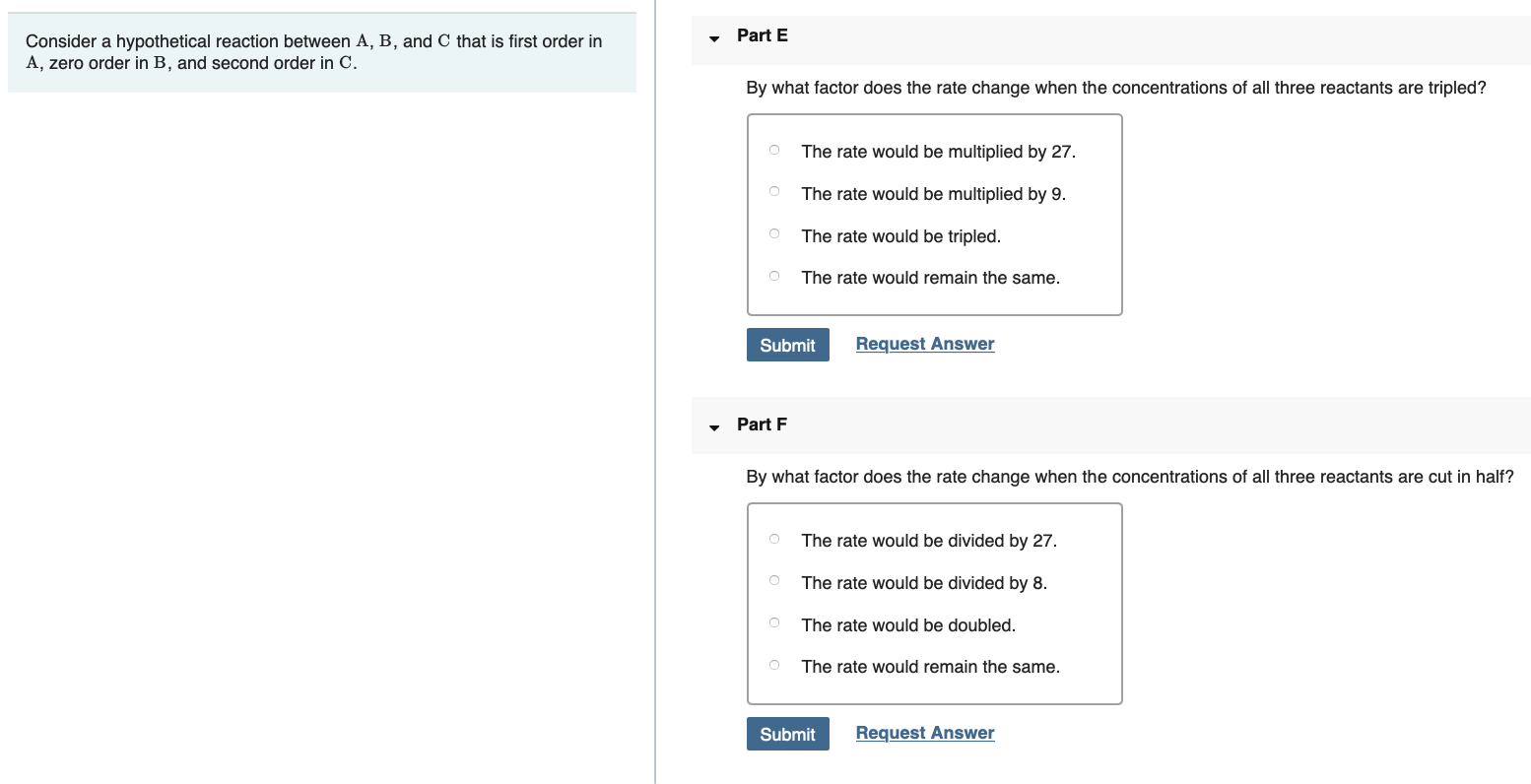Part E Consider a hypothetical reaction between A, B, and C that is first order in A, zero order in B, and second order in C. By what factor does the rate change when the concentrations of all three reactants are tripled? The rate would be multiplied by 27. The rate would be multiplied by 9. The rate would be tripled. The rate would remain the same. Request Answer Submit Part F By what factor does the rate change when the concentrations of all three reactants are cut in half? The rate would be divided by 27. The rate would be divided by 8. The rate would be doubled. The rate would remain the same. Request Answer Submit
Part E Consider a hypothetical reaction between A, B, and C that is first order in A, zero order in B, and second order in C. By what factor does the rate change when the concentrations of all three reactants are tripled? The rate would be multiplied by 27. The rate would be multiplied by 9. The rate would be tripled. The rate would remain the same. Request Answer Submit Part F By what factor does the rate change when the concentrations of all three reactants are cut in half? The rate would be divided by 27. The rate would be divided by 8. The rate would be doubled. The rate would remain the same. Request Answer Submit
Chemistry for Engineering Students
4th Edition
ISBN:9781337398909
Author:Lawrence S. Brown, Tom Holme
Publisher:Lawrence S. Brown, Tom Holme
Chapter11: Chemical Kinetics
Section: Chapter Questions
Problem 11.20PAE: Experimental data are listed here for the reaction B: Time (s) IB] (mol/L) 0.00 0.000 10.0 0.326...
Related questions
Question
I don't know how to solve this.

Transcribed Image Text:Part E
Consider a hypothetical reaction between A, B, and C that is first order in
A, zero order in B, and second order in C.
By what factor does the rate change when the concentrations of all three reactants are tripled?
The rate would be multiplied by 27.
The rate would be multiplied by 9.
The rate would be tripled.
The rate would remain the same.
Request Answer
Submit
Part F
By what factor does the rate change when the concentrations of all three reactants are cut in half?
The rate would be divided by 27.
The rate would be divided by 8.
The rate would be doubled.
The rate would remain the same.
Request Answer
Submit
Expert Solution
This question has been solved!
Explore an expertly crafted, step-by-step solution for a thorough understanding of key concepts.
This is a popular solution!
Trending now
This is a popular solution!
Step by step
Solved in 3 steps with 3 images

Knowledge Booster
Learn more about
Need a deep-dive on the concept behind this application? Look no further. Learn more about this topic, chemistry and related others by exploring similar questions and additional content below.Recommended textbooks for you

Chemistry for Engineering Students
Chemistry
ISBN:
9781337398909
Author:
Lawrence S. Brown, Tom Holme
Publisher:
Cengage Learning

Chemistry: An Atoms First Approach
Chemistry
ISBN:
9781305079243
Author:
Steven S. Zumdahl, Susan A. Zumdahl
Publisher:
Cengage Learning

Chemistry
Chemistry
ISBN:
9781305957404
Author:
Steven S. Zumdahl, Susan A. Zumdahl, Donald J. DeCoste
Publisher:
Cengage Learning

Chemistry for Engineering Students
Chemistry
ISBN:
9781337398909
Author:
Lawrence S. Brown, Tom Holme
Publisher:
Cengage Learning

Chemistry: An Atoms First Approach
Chemistry
ISBN:
9781305079243
Author:
Steven S. Zumdahl, Susan A. Zumdahl
Publisher:
Cengage Learning

Chemistry
Chemistry
ISBN:
9781305957404
Author:
Steven S. Zumdahl, Susan A. Zumdahl, Donald J. DeCoste
Publisher:
Cengage Learning


Chemistry & Chemical Reactivity
Chemistry
ISBN:
9781337399074
Author:
John C. Kotz, Paul M. Treichel, John Townsend, David Treichel
Publisher:
Cengage Learning

Chemistry: Principles and Reactions
Chemistry
ISBN:
9781305079373
Author:
William L. Masterton, Cecile N. Hurley
Publisher:
Cengage Learning